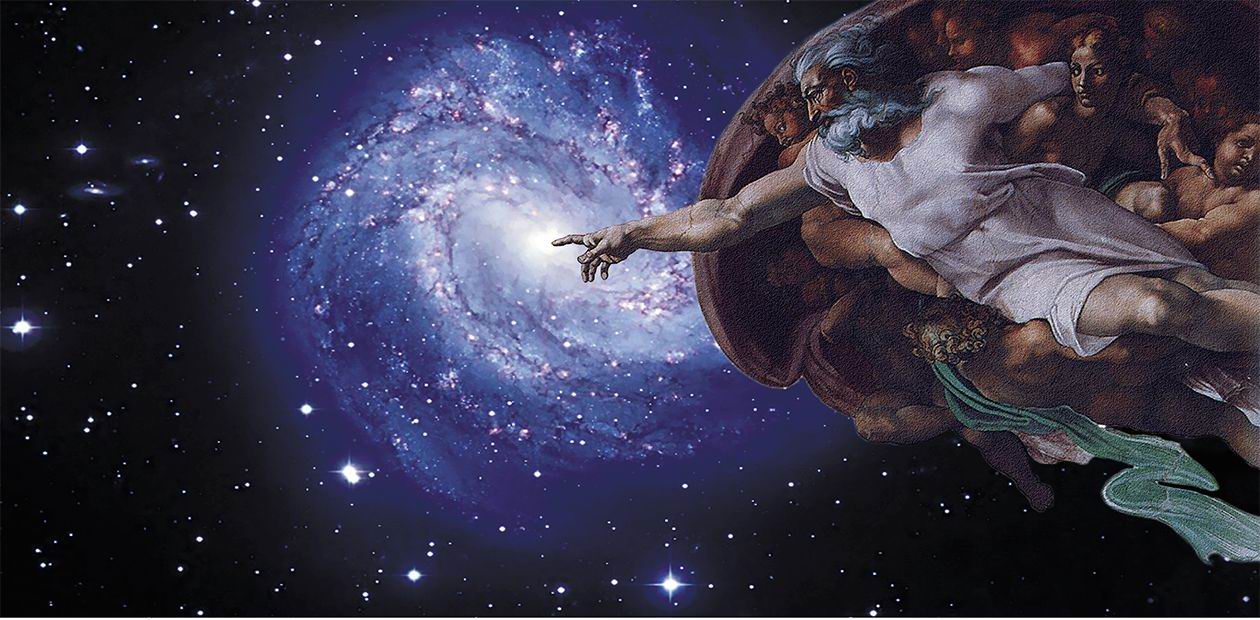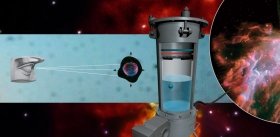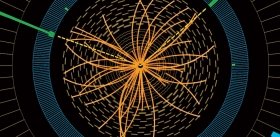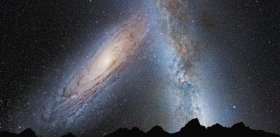Cosmology: Discoveries and Mysteries
Cosmology is a special kind of science. It studies the universe as an integral whole physical system with its specific features which are not reduced to the sum of features of astronomical bodies and physical fields populating it. The size of the observable universe is approximately 10 B LY. It makes the largest and unique object of study in science on a spatial scale. Obviously, in this regard cosmology considerably differs from other natural sciences. However, similarly to any other science, established facts, reliable information about real objects, processes, and phenomena are most important for cosmology. The article written by well-known Russian astrophysicists is devoted to the discussion of four major discoveries made in cosmology and difficult puzzles both old and quite new that are yet to be solved
The further the quicker
Modern cosmology goes back to the first decade of the 20th century. In 1915—1917 the American astronomer Vesto Slipher discovered that the galaxies (called nebulae at that time) do not stay in the same place but move in space, with the majority of them moving away from us. It was the conclusion that followed from the observations of the galaxies spectra: their movement manifested itself in the shift of spectral lines towards the red spectrum end.
Such a redshift, which can be interpreted as the Doppler shift, well known in physics, is universal and can be observed in all the galaxies of the Universe. The exceptions include the stellar systems the closest to us, such as the famous Andromeda nebula and other (smaller) galaxies located at distances not exceeding approximately 1 megaparsec (Mpc)*. If distances exceed 1 Mpc, then according to Slipher, the galaxies “disperse in space.”
In 1929 another American researcher, Edwin Hubble, who is often considered the greatest astronomer of the 20th century, determined that galaxies are receding from us at a velocity V of dispersion proportional to the distance R from us, i.e., V=HR. The ratio between velocity and distance is now called the Hubble law, while the constant of proportionality H is the Hubble constant. The value of H is constant in a sense that it is the same for all the galaxies and does not depend on either the distance to them or the direction to it in the sky. According to modern data, the value of the Hubble constant lies within the limits from 60 to 75 km/sec per megaparsec.
Today it is possible to observe how the galaxies are receding according to the Hubble law up to the distances of several thousand megaparsec. Let us say a galaxy is located at a distance of 1000 Mpc, then it is moving away from us at a speed of 60,000—75,000 km/sec. It is an enormous speed, one-forth or one-fifth of the speed of light. It can be said that the universal receding of galaxies is the mightiest phenomenon in nature.
EDWIN HUBBLE (1889—1953), AN ASTRONOMER FROM THE MOUNT WILSON OBSERVATORY (CALIFORNIA) , OBSERVED THE GALAXIES WITH THE HELP OF THE MOST POWERFUL TELESCOPE OF HIS TIME WITH THE DIAMETER OF 2.5 M. IN 1929, HE ESTABLISHED A QUANTITATIVE LAW IN THE PHENOMENON OF RECEDING GALAXIES (THE HUBBLE LAW)Discoveries made by Slipher and Hubble along with the subsequent research studies laid the foundation for the observations on which modern cosmology is built and develops. It is now known that we live in a vast world, which is expanding with time. The expansion of the Universe started about 14 billion years ago, with this huge period being considered the age of the world. The event that caused the cosmological expansion is called the Big Bang.
But what is the physical nature of the Big Bang? Where have the enormous speeds of recession come from? What has made the galaxies recede from each other at a sweeping speed? These questions have been left unanswered both by well-known astronomers-observers, founders of cosmology, and great physicists, starting with A. Einstein. Today, cosmologists do not have the answer to this question either. It is possible that this is the most difficult puzzle of all those that have ever existed in natural sciences that does not yield to solution. We do not know what the cosmological expansion started from, neither have we an idea about the physics that could support this phenomenon. We even do not know how the problem of cosmological expansion should be formulated. Even more than that, nothing can be said about what happened before this event; it is not quite clear even what “before” here means.
Nevertheless, the possibility that the world can expand was predicted by the Russian mathematician Alexander Friedmann, a classic international scholar. Using the Einstein theory, in 1922—1924 A. Friedmann developed a physical and mathematical model of the world found in the state of general expansion. The law of proportionality between speed and distance came as a direct consequence of this model, forming the basis of observations in modern cosmology, was discovered in observations conducted by Hubble. Friedmann’s cosmological model laid theoretical foundation for modern cosmology. Together with the data of astronomical observations, Friedmann’s cosmological model very well describes the dynamics of cosmological expansion. It is true that it is not described from the very beginning, about which nothing is known. But it is great that Friedmann’s theory is true right after the first second of cosmological expansion. Except for the first second, the history of the world is known to us; in addition, this theory predicts the future of the Universe and says that the cosmological expansion will continue for an indefinitely long period of time.
Excessive weight of the Universe
In 1933, Swiss-American astronomer Fritz Zwicky noticed that in addition to the galactic luminescent matter there must be some invisible, “hidden” masses in the Universe which only manifest their presence by their gravitation. He studied the Coma cluster of galaxies in the Berenices Hair constellation, a large body containing thousands of stellar systems similar to the Andromeda nebula or our Galaxy. In this cluster, galaxies move at speeds reaching 1000 km/s. Thus to keep them in the cluster volume such gravitation is necessary that only visible, luminescent masses of galaxies themselves are incapable to create. Stronger gravitation is required, which according to Zwicky’s calculations requires additional masses that approximately 10 times exceed the total visible mass of the galaxies in the cluster.
Later, in the 1970s, astronomers from the USSR and USA discovered that hidden masses must be present not only in the clusters of galaxies but in isolated large galaxies as well. Jaan Einasto, Vera Rubin, Jeremiah P. Ostriker, and Jim Peebls together with their colleagues found out that hidden masses form an invisible halo around galaxies. The matter is that it is possible to measure the dependence between the speed of rotation of spiral galaxies and the distance from the center (rotation curve), which can be traced both in the stellar system and outside it by the movement of clouds containing neutral hydrogen. As a rule, in the zone outside the visible disk of the galaxy, the rotation curve becomes flat i.e., it practically does not depend on the distance. In all the cases, this “flat” dependence indicates the presence of hidden matter inside and outside the stellar system, with the mass of invisible matter in the halo being 3—10 times larger than that of the galaxy.
These halos are almost spherical in shape, with their radii exceeding the size of the stellar systems by 5—10 times. Such large galaxies as the Andromeda nebula or our own Galaxy consist of a stellar disk submerged in the distribution of invisible mass, which stretches to the distances of up to 100 kpc. These dark halos as the additional masses introduced by Zwicky manifest themselves exclusively by gravitation. Invisible matter filling the galaxies’ and clusters’ halo is now commonly referred to as the dark matter.
Other interesting empirical data supporting the existence of dark matter are connected with the gravitational lens effect. Clusters of galaxies create the A. Einstein effect of light “bent” by the gravitational field. In this case, remote galaxies and quasars serve as sources of light. The images of galaxies become distorted when their light travels through the cluster’s gravitational field, which serves as a kind of gravitational lens. They distinguish strong and weak lensing. At strong lensing the distortion is so considerable that there appear several images of the source. It happens when the angular distance between the lens and the source is relatively small. At relatively large angular distances the distortion is not so considerable (weak lensing) and is limited to changes in the visible part of the source already without fragmentation of its image. In both cases, this effect serves as an indication of the mass of the cluster, which serves as a gravitational lens. By studying such distortions for hundreds of thousands and millions of remote galaxies it is possible to receive the data about the size of the lenses-clusters and mass distribution in them. Such observations invariably indicate that the clusters contain a large amount of hidden mass.
The discovery of the dark matter is the second most important event in the history of cosmology, with the first being the discovery of cosmological expansion. The ordinary matter from which the Earth and everything on it (including us as well as the Sun and other stars) consists is comprised of only three elementary particles – protons, neutrons and electrons. The dark matter contained in the Universe in much larger amounts has a completely different composition: these are neither baryons (protons and neutrons), nor electrons; actually, nobody knows what it consists of.
A quarter of a century ago Ya. B. Zeldovich was actively developing the idea that the dark matter could consist of neutrino. The Universe indeed contains cosmological neutrino (and antineutrino).
Their balance with the substances was disturbed when the age of the world was less than one second and since then they have been present in space interacting with other kinds of energy almost exclusively gravitationally. There must be about 300 of them in every cubic centimeter of space. In the beginning of the 1980s, it seemed that a laboratory physical experiment allowed these particles to have masses suitable for a neutrino to play the role of dark matter. However, it has become clear by now that the mass of neutrinos is considerably smaller, so that they can be attributed 10% of the dark matter at best. What are the main carriers of this substance?
ACCORDING TO A HYPOTHESIS THE DARK MATTER CONSISTS OF PARTICLES IN A WAY SIMILAR TO NEUTRINOS. HOWEVER, SUCH PARTICLES MUST BE APPROXIMATELY 1000 TIMES HEAVIER THAN A PROTONOne of the modern hypotheses derived from Ya. B. Zeldovich’s idea lies in the fact that the dark matter mostly consists of particles in a way similar to neutrinos: they are stable, do not have an electric charge and participate only in gravitational and weak interactions. However, such particles must be very heavy, approximately 1000 times heavier than a proton, so that the rest energy is approximately 1 TeV. To this day, such particles have not been known in either theory or physical experiment. If they do exist, then according to theory they could be present in the Universe in the necessary quantity. It has led cosmology to the following interesting prediction: stable, massive, elementary particles with weak interaction which account for about 25% of all the mass and energy of the Universe, making a 4—5 times larger contribution to them than that made by baryons must exist in nature.
It is possible that the particles with the necessary properties will be discovered on the Large Hadrone Collider in CERN where unprecedented experiments are being planned. On this most powerful accelerator, proton beams will be accelerated to the energies of more than 10 TeV, which significantly exceeds the rest energy of hypothetical dark particles. In a number of largest laboratories around the world, including the laboratories in Russia, special accelerators are being constructed to detect dark matter particles, which reach the Earth from the halo of our Galaxy. It is not inconceivable that the question of physical nature of the dark matter will be answered in the nearest future. In any event, the resolution of this mystery does not seem as hopeless anymore as the resolution of the question about the nature of cosmological expansion.
The photon background
In 1965, American radio astronomers Arno Penzias and Robert Wilson discovered that the Universe is permeated with electromagnetic radiation coming to Earth isotropically, i.e., uniformly in all the directions. That is the third biggest discovery in cosmology.
The maximum in this spectrum lies in the millimeter range, with the spectrum itself, i.e., the distribution of the wavelengths (or frequencies) coinciding in shape with the spectrum of an absolutely dark body. In the language of quanta, it is possible to say that there is a gas of photons in the world, which uniformly fill the space. The temperature of this gas has been measured precisely and equals T = 2, 725 K. It can be seen that this temperature is very low and does not exceed 3 degrees counting from absolute zero (it corresponds to -2700 on Celsius scale). There is an enormous number of such cosmic photons in the Universe: their number is almost 10 billion times more than that of protons if to calculate by the number of particles. One cubic centimeter of space contains approximately 500 relict photons.
Isotropic cosmic radiation itself does not contain any special mysteries. It is relict, i.e., it presents a remnant of the condition in which the Universe was found in remote past, in the first minutes of its expansion. At that time, there were neither stars nor galaxies, while all the substance was distributed in space more or less evenly. You can imagine it if you can mentally turn back the progress of time: looking back, we can see that the galaxies are not moving away from each other but approaching each other. Then, at a certain moment they should move in such a way that their substance will become a gas of approximately homogeneous density. This gas must be very hot. From school days we know that bodies cool down on expansion and heat up on compression. It is also known from physics that hot gas must contain photons in thermodynamic equilibrium with it. When the Universe expands, the photons do not disappear and must be preserved until the modern era.
This was what George Gamow, once a student of Professor Friedmann in Leningrad, thought as far back as in the 1940s. He created the theory of “hot Universe,” which is also called the Big Bang theory, with the help of which he was able to predict the existence of this remnant, relict radiation. More than that, he predicted the current temperature of relict photons. According to his calculations, it could not exceed 10K. In one of his popular science articles (1950), G. Gamow wrote that the temperature must be about 3 degrees on the absolute scale. As it was discovered in fifteen years, his predictions were very precise. Many scientists consider this prediction to be the most beautiful quantitative prediction in the entire cosmological theory.
But there still are some unclear issues regarding relict radiation. The cosmologists have not yet been able to understand why there are not so many relict photons compared to protons. However, it would be more correct to say that this is not the question about photons but rather the question about protons: why their number is such as known from observations. This question has not been answered yet. Even A. D. Sakharov, who thought that this problem to be one of the principle problems not only for cosmology but also for fundamental physics as a whole, was not able to answer this question.
GEORGE GAMOW (1904—1968), 15 YEARS BEFORE PENZIAS AND WILSON MADE THEIR DISCOVERY, FORESAW THAT THE TEMPERATURE OF RELICT RADIATION MUST BE ABOUT THREE DEGREES. IT WAS THE MOST PRECISE QUANTITATIVE PREDICTION IN COSMOLOGYFor the discovery and study of relict radiation two Nobel Prizes were awarded: the first one to A. Penzias and R. Wilson in 1978, and the second one to George Smoot and John Mather in 2006, who proved in 1992 that relict radiation indeed presents thermodynamically equilibrium photon gas at a certain temperature. It was made with the help of American satellite COBE (Cosmic Background Explorer). In addition, COBE measured weak anisotropy of photon radiation to the thousandth of one percent. The latter presents a “print” of weak inhomogeneity of the substance in the early Universe, which later gave start to observable large scale space structures – galaxies and galactic clusters.
Nowadays relict radiation observations help the astronomers to study large-scale properties of the Universe. The brightest result achieved on this way in the recent years concerns the geometry of 3D space where receding of galaxies is taking place. Starting with Friedmann, cosmologists have tried to find out the type of geometry of the real space. It has turned out to be simple Euclidian geometry. Thus, the construction of the world is not that complicated: at least its spatial geometry is the simplest of the possible.
Universal antigravitation
In 1998–1999 two international groups of observers, one of them supervised by Brian Schmidt and Adam Rice and the other by Sal Perlmather, established that the observable cosmological expansion was developing with an acceleration: the speeds at which the galaxies are receding are increasing with time. The discovery was made with the help of studying remote flashes on the supernovae of a certain type (Ia), whose distinguishing feature was that they can serve as “standard candles,” i.e., the sources which have a known luminosity. Their exceptional brightness makes it possible to observe them at very large, truly cosmological distances making thousands of megaparsec.
The substance, dark matter including, is incapable of accelerating the galaxies; it can only slow down their receding: mutual gravitation of galaxies is drawing them closer together. For this reason, accelerated expansion discovered by the astronomers points to the fact that along with ordinary substance creating gravitation there is a special cosmic mass or energy, which does not create gravitation but creates antigravitation – universal repulsion of bodies. It is important to note that on the cosmological scale antigravitation is stronger than gravitation. New energy was called dark energy. It is genuinely invisible: it does not emit, disperse or absorb light (or any electromagnetic waves); it manifests itself only in antigravitation.
The astronomers have found out that to the distances of about 7 billion light years cosmological acceleration is positive. However, at even larger distances acceleration has turned out to change the sign: there it is negative, thus at such super high distances cosmological expansion is taking place at deceleration.
It should be taken into account that light spreads in space at a finite velocity. It means that we see the objects the way they were when they emitted the light being received by us now. We see the Sun at an 8-minute delay; we see remote galaxies the way they were billions of years ago. A telescope is a true time machine that allows seeing with our own eyes the past of the world. Its age is 13.7 billion years – this is the freshest cosmological data.
What has been just said above about cosmological acceleration means that the first half of its history the Universe was expanding at deceleration, while the second half at acceleration. The first 7 billion years the Universe practically did not feel the presence of dark energy in it: the density of substance (dark matter and baryons) was considerably lower than the density of dark energy. It is supposed that the density of dark matter does —it is not depend on time constant value, while the density of substance is decreasing in the process of expansion. It means that in the past it was higher than now. For this reason, until a certain moment gravitation of substance was higher than dark energy antigravitation. These are the two forces whose values became equal approximately 7 billion years ago. Since then the dark energy has dominated. This era of antigravitation will last for an indefinitely long period.
By now, the aggregate of different observations, including those of relict radiation, have helped to establish the share of each space component in the global energy balance in the Universe. These components are now referred to as different kinds of cosmic energy. The share of dark energy is approximately 70% of total energy; dark matter 25%; ordinary matter (protons, neutrons, and electrons) about 5%; relict radiation less than 0.1 %. This is the recipe of “energy mix” filling the modern Universe. As can be seen, there is a lot of “dark” in it, up to 95%. It has become the most unexpected result for astronomers, cosmologists, and physicists.
The scientific foresight A. Einstein possessed is surprising and worth admiration: as far back as in 1917 he talked about universal repulsion as a possible physical phenomenon of cosmological scale. A. Einstein described antigravitation using only one constant called cosmological. All the observation data about dark energy available now correspond well with A. Einstein’s description.
A. Einstein did not leave us a physical interpretation of the cosmological constant. According to E. B. Gliner’s proposal made in 1965, the cosmological constant can be considered as a physical characteristic of a special continuous medium ideally uniformly filling all the space of the Universe. The density of this medium is not only homogeneous, but in addition does not depend on time – it is the same in all the systems of reference. Based on these parameters, macroscopic properties of the dark matter can be derived. It turns out that it has pressure, which, in addition, is negative but equals the energy density in absolute magnitude (let us remember that energy density and pressure have the same dimension). It is because of its negative pressure that the dark energy creates antigravitation, a special effect of the general theory of relativity.
ANTIGRAVITATION IS CREATED NOT BY THE GALAXIES OR OTHER COMPACT OBJECTS BUT BY DARK ENERGY, A CONTINUOUS MEDIUM IN WHICH ALL THE BODIES ARE SUBMERGEDBut what are the microscopic, not the macroscopic properties of dark energy? What does it consist of? In the late 1960s, long before the dark energy was discovered, Ya. B. Zeldovich discussed the possible connection between the cosmological constant and quantum vacuum of elementary particles and physical fields. This physical vacuum is not absolute emptiness but has its own nonzero energy. It is carried by the so-called zero-point oscillations of quantum fields which always exist in space even when there are no particles present in it. If this quantum vacuum is considered on the macroscopic level as a certain medium, then it can be assigned not only a value of energy density, but also pressure. In this case, the connection between the pressure and density must be exactly the same as that of the dark energy described by the Einstein’s cosmological constant. Then the question arises: cannot the dark energy be identical to the physical vacuum?
It would be great if it were possible to prove that this is indeed so: the unification of seemingly different essences is the most productive path in the development of science. It has been known already from the times of J. Maxwell who combined electricity and magnetism. However, until now scientists have failed in either proving or disproving the idea put forward by Ya. Zeldovich. The physical nature and microscopic structure of the dark energy has become the core problem of both cosmology and fundamental physics. It seems that this question is as complex as that of the origin of the cosmological expansion.
To conclude, during the 90 years of its existence counting from the first observations made by Vesto Slipher and the theoretical work of A. Einstein, cosmology has transformed from the field of abstract, almost airy activities at the remote periphery of the then science into one of the central directions in natural science in the 21st century. It possesses reliable basis for observations built upon the fundamental facts about the Universe. Upon it, the theory is built and being developed, which is tightly connected with all the fields of modern physics, including the general theory of relativity, nuclear physics, and elementary particle physics. Cosmology asks new important questions, puts forward substantial ideas, and makes daring predictions. It has created a broad, rich and coherent view of the world, which is becoming an indispensable part of the common culture of the humankind. As for unresolved problems, they should always be present in a living and complex science as a source of and a reserve for its further development.
References
Veinberg S. Pervyye tri minuty (The first three minutes). Moscow, Atomizdat, 1982.
Novikov I. D., Sharov A. S. Chelovek, otkryvshy vzryv Vselennoy (The Man who Discovered the Big Bang). Moscow, Nauka, 1989.
Rozental I. L. Elementarnyie chastitsy i struktura vselennoy. (The Elementary Particles and the Structure of the Universe). Moscow, Nedra, 1984.
Tropp E. A., Frenkel V. Ya, Chernin A. D., Friedmann A. A. Trudy i zhizn (Works and Life). Moscow, Nauka, 1988.
Cherepashchuk A. M, Chernin A. D. Vselennaya, zhizn, chernyye dyry. (The Universe, Life and the Black Holes). Fryazino: Vek-2, 2003.
Cherepashchuk A. M, Chernin A. D. Gorizonty Vselennoy. (The Horizons of the Universe). Novosibirsk: Izdatelstvo SB RAS, 2005.
* 1 megaparsec = 1 000 000 parsec; 1 parsec ~ 3,26 light years










